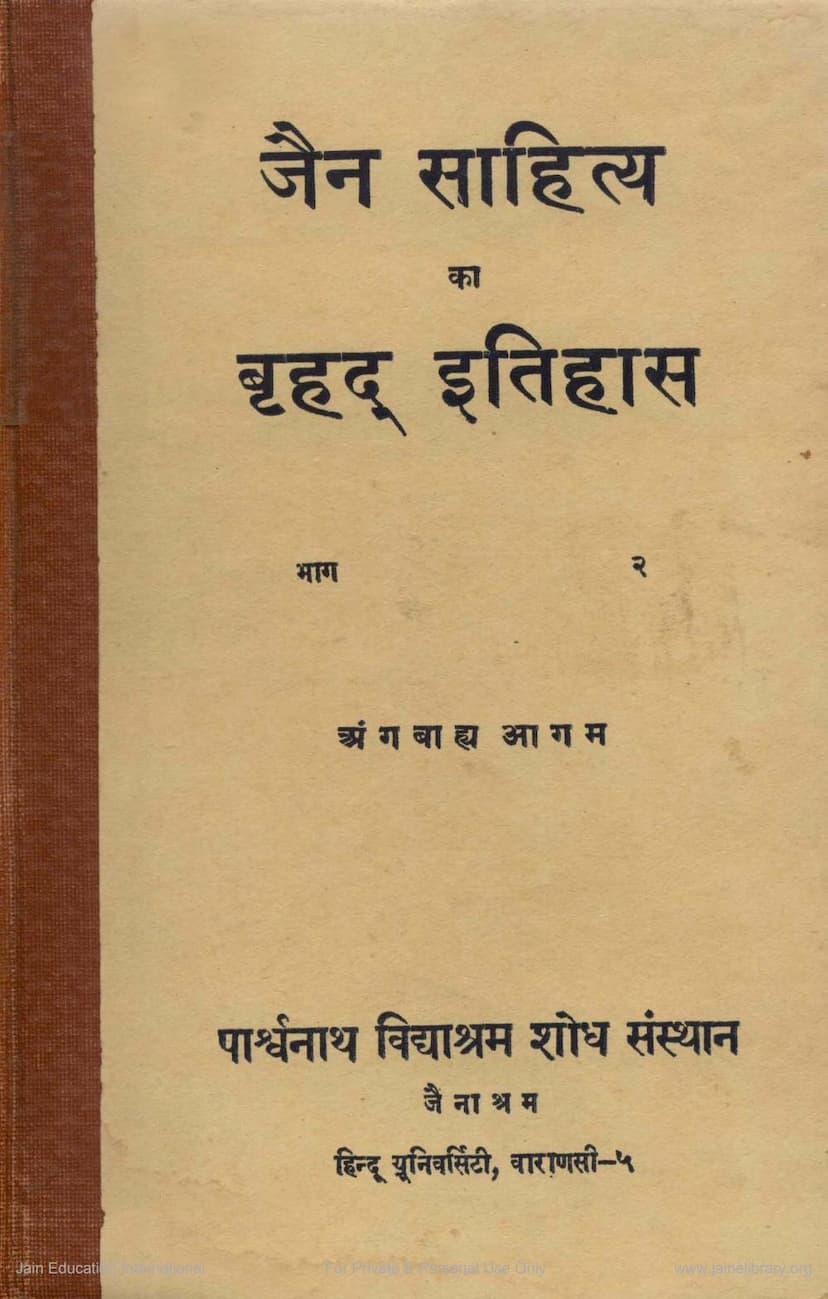Jain Sahitya Ka Bruhad Itihas Part 2
Added to library: September 2, 2025

Summary
Here's a comprehensive summary of "Jain Sahitya Ka Bruhad Itihas Part 2: Ang Bahya Agama" by Jagdishchandra Jain and Mohanlal Mehta, based on the provided text:
This volume, the second part of a larger history of Jain literature, focuses on the Ang Bahya Agama, which are canonical texts external to the twelve Angas of Jain scripture. The book aims to provide a thorough overview of these scriptures, complementing the first volume's coverage of the Angas. A third volume is planned to cover interpretive literature.
The authors, Dr. Jagdishchandra Jain and Dr. Mohanlal Mehta, highlight that the Angas were composed by the immediate disciples of Lord Mahavir (Ganadharas), while the Ang Bahya Agamas were compiled by various enlightened monks (Gitartha Sthaviras) at different times.
The Ang Bahya Agamas are categorized into five sections:
- Upanga: This category includes twelve texts: Aupapātika, Rājapraśnīya, Jīvā-jīvābhigama, Prajñāpanā, Sūryaprajñapti, Candraprajñapti, Jambu-dvīpa-prajñapti, Nirayāvalikā (or Kalpikā), Kalpāvatansikā, Puṣpikā, Puṣpacūlikā, and Vr̥ṣṇidaśā. The text notes that Prajñāpanā's composition date is certain, attributed to Śyāmārya (also known as Kālaka-acharya) between 135-94 BCE. The exact authors and precise dates for the remaining Upangas are unknown, but they are generally considered to pre-date the Common Era.
- Mūlasūtra: Four texts are identified as Mūlasūtras: Uttarādhyayana, Āvaśyaka, Daśavaikālika, and Piṇḍa-niyukti (or Ogha-niyukti). Daśavaikālika is attributed to Ācārya Śayyambhav (fl. around 75 CE), placing its composition between 395-372 BCE. Uttarādhyayana is not the work of a single author or era but is considered to be from the 2nd-3rd century BCE. Āvaśyaka, being essential for monks, is presumed to be ancient. Piṇḍa-niyukti and Ogha-niyukti are attributed to Ācārya Bhadrabāhu (II), who lived in the 5th-6th century CE.
- Chedasūtra: Six texts fall under this category: Daśāśrutaskandha, Br̥hatkalpa, Vyavahāra, Niśītha, Mahāniśītha, and Jītākalpa (or Pañcākalpa). Daśāśrutaskandha, Br̥hatkalpa, and Vyavahāra are works of Ārya Bhadrabāhu (I), dating to around 300 BCE. Niśītha is attributed to Ārya Bhadrabāhu or Viśākhagaṇi Mahattara and is considered a part of the Ācārāṅga's fifth Cūlikā that was later separated. Mahāniśītha's compilation is credited to Ācārya Haribhadra. Jītākalpa is attributed to Ācārya Jinvadhra (7th century CE). The Pañcakalpa is currently unavailable.
- Cūlikāsūtra: These are the Nandī and Anuyogadvāra sutras. Devavācaka is credited with Nandī Sūtra (pre-6th century CE), while Ārya Rakṣita (died 584 CE) authored Anuyogadvāra Sūtra.
- Prakīrṇaka: Ten texts are considered prominent among the Prakīrṇakas: Catuhśaraṇa, Ātura-pratyākhyāna, Mahāpratyākhyāna, Bhaktaparijñā, Tandalavaicārika, Sanstāraka, Gacchācāra, Gaṇividyā, Devendrastava, and Maraṇasamādhi. Catuhśaraṇa and Bhaktaparijñā are attributed to Vīrabhadra-gaṇi (11th century CE). The authors and dates of the other Prakīrṇakas are uncertain.
The book then proceeds to provide detailed introductions to each of these categories and their constituent texts. Notably, the introduction to the Aupapātika Sūtra (first Upanga) describes the city of Campā in vivid detail, the political climate, and the arrival of Lord Mahavir. It also recounts King Kunika's (Ajātashatru's) regal procession and the profound sermon delivered by Mahavir. The text delves into various philosophical discussions, such as the nature of the soul and body, and provides classifications of different ascetics and their practices.
The summary of Rājapraśnīya Sūtra (second Upanga) highlights King Paesi's challenge to Keśikumāra regarding the nature of the soul and body. It also describes the celestial realms and the elaborate preparations made by Surya-bh Deva for a performance.
The Jīvā-jīvābhigama Sūtra (third Upanga) is presented as a detailed treatise on the classification of living beings (jivas) and non-living entities (ajīvas), covering aspects like sensory organs, lifespans, rebirths, and the composition of the universe.
The Prajñāpanā Sūtra (fourth Upanga) is described as a highly extensive text dealing with numerous philosophical and cosmological concepts, categorized into 36 "pads" or topics, including karma, leśyā, and the nature of various beings.
The Sūryaprajñapti and Candraprajñapti Sūtras (fifth Upanga) are presented as astrological texts detailing the movements of the sun, moon, and stars, including their cycles, influences, and celestial mechanics, acknowledging the Jain cosmological concept of multiple suns and moons.
The Jambū-dvīpa-prajñapti Sūtra (sixth Upanga) is detailed as a cosmological text describing the structure of the universe, particularly the Jambū-dvīpa continent, its mountains, rivers, flora, fauna, and the celestial beings inhabiting it, along with accounts of Lord Rishabhadeva's life and the creation of the Ikshvāku dynasty.
The Nirayāvalikā Sūtra and its associated texts (Kalpikā, Kalpāvatansikā, Puṣpikā, Puṣpacūlikā, Vr̥ṣṇidaśā) are introduced as stories recounting the past lives and karmic consequences of various individuals, offering moral lessons.
The Mūlasūtras section begins with Uttarādhyayana, highlighting its ancient language and themes, and its comparison to Buddhist texts. It details the contents of the Āvaśyaka, Piṇḍa-niyukti, and Ogha-niyukti, focusing on monastic discipline and ethical conduct.
The Chedasūtras section provides an in-depth explanation of the importance and structure of these disciplinary texts. Daśāśrutaskandha is described as an exhaustive guide to monastic conduct, covering various social and spiritual aspects. Br̥hatkalpa, Vyavahāra, Niśītha, and Mahāniśītha are presented as manuals detailing rules, regulations, offenses, and their corresponding penances for Jain monks and nuns. The summary emphasizes the meticulous classification of offenses and the graded system of penances in these texts.
The Cūlikāsūtras section focuses on Nandī and Anuyogadvāra, explaining their role as introductory and foundational texts for understanding Jain canonical literature. Nandī provides a detailed classification of knowledge, while Anuyogadvāra elucidates the methodology of interpreting Jain scriptures.
The Prakīrṇaka section covers miscellaneous texts like Catuhśaraṇa (four refuges), Ātura-pratyākhyāna (renunciation for the sick), Mahāpratyākhyāna (great renunciation), Bhaktaparijñā (understanding of sustenance), Tandalavaicārika (rice contemplation), Sanstāraka (asceticism), Gacchācāra (monastic conduct within a sect), Gaṇividyā (knowledge of classification), Devendrastava (hymn to Indra), and Maraṇasamādhi (meditation on death). These texts often contain moral stories and philosophical insights.
Finally, the text concludes with an extensive bibliography of related works.
In essence, "Jain Sahitya Ka Bruhad Itihas Part 2" serves as a scholarly exposition of the Ang Bahya Agama, offering a systematic and detailed overview of their content, authors, historical context, and philosophical significance within the Jain tradition.